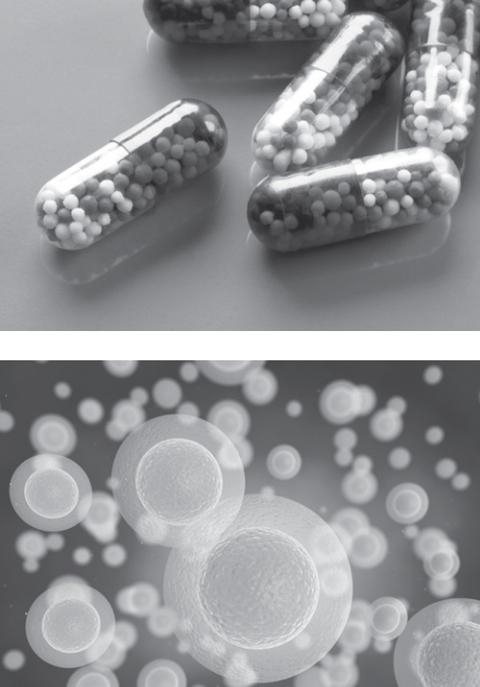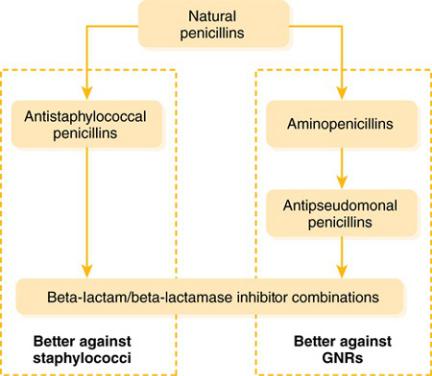
- •Contents
- •Acknowledgments
- •Introduction
- •New to the Fourth Edition
- •PART 2: Antibacterial Drugs
- •Penicillins
- •Natural Penicillins
- •Antistaphylococcal Penicillins
- •Aminopenicillins
- •Antipseudomonal Penicillins
- •Cephalosporins
- •Second-Generation Cephalosporins
- •Third-Generation Cephalosporins
- •Anti-MRSA Cephalosporins
- •Carbapenems
- •PART 3: Antimycobacterial Drugs
- •PART 4: Antifungal Drugs
- •Fluconazole
- •Itraconazole
- •Voriconazole
- •Posaconazole
- •Isavuconazole
- •PART 5: Antiviral Drugs
- •Nucleoside and Nucleotide Reverse Transcriptase Inhibitors
- •Non-nucleoside Reverse Transcriptase Inhibitors (NNRTIs)
- •Protease Inhibitors
- •Integrase Inhibitors
- •Entry and Fusion Inhibitors
- •PART 6: Antiparasitic Drugs
- •Appendix 2: Spectrum of Activity
- •Appendix 3: Empiric Regimens for Common Infections
- •Index

PART 2: Antibacterial Drugs

7: Beta-Lactams
Introduction to Beta-Lactams
Beta-lactams include a wide variety of antibiotics that seem to exist only to confuse both students and clinicians. Penicillins, cephalosporins, and carbapenems are all beta-lactams. Monobactams (aztreonam) are structurally similar, but they lack one of the two rings that other beta-lactams have and have little to no cross-allergenicity with other beta-lactams. To make matters more confusing, not all beta-lactams end in -cillin or -penem or start with ceph-.
We believe the best approach to keeping beta-lactams straight is to group them into classes and learn the characteristics of each class. If you work in a hospital, you will likely have only one or two drugs of each class to worry about. In the outpatient setting, you will encounter many more of them. Fortunately, all beta-lactams have a few things in common:
 All beta-lactams can cause hypersensitivity reactions, ranging from mild rashes to drug fever to acute interstitial nephritis (AIN) to anaphylaxis. There is some cross-sensitivity among classes, but there is no way to predict exactly how often that will occur. Studies on the matter differ greatly in their conclusions, though on the whole cross-sensitivity seems to be lower between different types of beta-lactams than previously thought. There is an evolving school of thought that the similarities between side chains of beta-lactams are responsible for cross-sensitivity and that the likelihood of allergic reactions can be predicted by them, but this has not disseminated widely into clinical practice.
All beta-lactams can cause hypersensitivity reactions, ranging from mild rashes to drug fever to acute interstitial nephritis (AIN) to anaphylaxis. There is some cross-sensitivity among classes, but there is no way to predict exactly how often that will occur. Studies on the matter differ greatly in their conclusions, though on the whole cross-sensitivity seems to be lower between different types of beta-lactams than previously thought. There is an evolving school of thought that the similarities between side chains of beta-lactams are responsible for cross-sensitivity and that the likelihood of allergic reactions can be predicted by them, but this has not disseminated widely into clinical practice.
 Seizures can result from very high doses of any beta-lactam, and some cause other neurologic effects. Accumulation to toxic levels can occur when the dose of a beta-lactam is not properly adjusted for a patient’s renal function. Did you check your patient’s renal function?
Seizures can result from very high doses of any beta-lactam, and some cause other neurologic effects. Accumulation to toxic levels can occur when the dose of a beta-lactam is not properly adjusted for a patient’s renal function. Did you check your patient’s renal function?
 All beta-lactams share a mechanism of action—inhibition of transpeptidases (i.e., penicillin-binding proteins) in the bacterial cell wall. Thus, giving two beta-lactams in combination for the same infection is generally not useful, but also not antagonistic (the penicillin-binding protein doesn’t care which drug binds to it). There are a few exceptions to this rule, but not many.
All beta-lactams share a mechanism of action—inhibition of transpeptidases (i.e., penicillin-binding proteins) in the bacterial cell wall. Thus, giving two beta-lactams in combination for the same infection is generally not useful, but also not antagonistic (the penicillin-binding protein doesn’t care which drug binds to it). There are a few exceptions to this rule, but not many.
 All beta-lactams lack activity against atypical organisms such as
All beta-lactams lack activity against atypical organisms such as
Mycoplasma pneumoniae and Chlamydophila pneumoniae. Add another drug to your regimen if you are concerned about these bugs, as in cases of community-acquired pneumonia.
 Nearly all currently available beta-lactams lack activity against MRSA. Add vancomycin or another agent if this bug is suspected (but note that its epidemiology is changing). Among the available beta-lactams, only the cephalosporin ceftaroline has anti-MRSA activity. It is the exception that proves the rule.
Nearly all currently available beta-lactams lack activity against MRSA. Add vancomycin or another agent if this bug is suspected (but note that its epidemiology is changing). Among the available beta-lactams, only the cephalosporin ceftaroline has anti-MRSA activity. It is the exception that proves the rule.
Once you know the similarities among beta-lactams, it is easier to learn the differences among them.
Penicillins
Introduction to Penicillins
Penicillins are one of the largest and oldest classes of antimicrobial agents. Since the development of the natural penicillins in the 1930s, further penicillin development has been directed by the need to combat increasing antimicrobial resistance. Classes of penicillins with expanded Gram-negative spectra overcome the shortfalls of natural penicillins, and they can be grouped fairly easily by spectrum of activity.
Penicillins have several things in common:
 Penicillins have very short half-lives (< 2 hours) and must be dosed multiple times per day. The half-lives of most of them are prolonged in the presence of renal dysfunction.
Penicillins have very short half-lives (< 2 hours) and must be dosed multiple times per day. The half-lives of most of them are prolonged in the presence of renal dysfunction.
 Like other beta-lactams, penicillins can cause hypersensitivity reactions. If a patient has a true IgE-mediated hypersensitivity reaction to a penicillin, other penicillins should be avoided, even if they are from different
Like other beta-lactams, penicillins can cause hypersensitivity reactions. If a patient has a true IgE-mediated hypersensitivity reaction to a penicillin, other penicillins should be avoided, even if they are from different

subclasses of penicillins. If the reaction is not severe, cephalosporins or carbapenems may be useful.
 Many penicillins are relatively poorly absorbed, even those available as oral formulations. This can lead to diarrhea when oral therapy is needed. Pay attention to the dosing of oral versus intravenous (IV) penicillins— often, a conversion from IV to oral therapy means there will be a substantial decrease in the amount of active drug in the body.
Many penicillins are relatively poorly absorbed, even those available as oral formulations. This can lead to diarrhea when oral therapy is needed. Pay attention to the dosing of oral versus intravenous (IV) penicillins— often, a conversion from IV to oral therapy means there will be a substantial decrease in the amount of active drug in the body.
Many penicillins were developed after the natural penicillins became available. Until researchers developed beta-lactamase inhibitors, development primarily focused on either improved activity against staphylococci (MSSA) or GNRs (Figure 7–1).
Figure 7–1 Penicillin Drug Development
Natural Penicillins
Agents: penicillin G, penicillin V
All of us have heard of the discovery of penicillin by Sir Alexander Fleming in 1929. Once penicillin was produced in medically useful quantities years later, it had a major impact on society, particularly in the treatment of wound infections. The importance of this discovery became apparent during World War II, when the Allies had access to lifeand limb-saving penicillin and the Axis did not. Unfortunately, staphylococci quickly became resistant to penicillin through the production of penicillinases (beta-lactamases active against penicillins), initiating the search for new beta-lactams and leading to the confusing array of these drugs available today. The development of resistance has narrowed the spectrum of effectiveness of natural penicillins considerably over the past 60 years, such that staphylococci are almost universally resistant to them. Occasionally we still see an isolate of
Staphylococcus aureus that does not produce penicillinase and is susceptible to penicillin.
Mechanism of Action
All beta-lactams inhibit cross-linking of peptidoglycan in the cell wall, leading to autolysis and cell death.
Spectrum
Good: Treponema pallidum, most streptococci, including Streptococcus pneumoniae
Moderate: enterococci
Poor: almost everything else
Adverse Effects
Similar to those of other beta-lactams.
